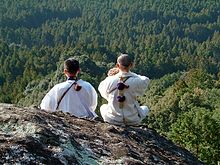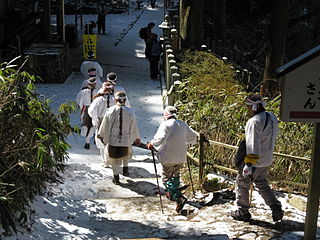Shugendō





Shugendō (修験道, lit. the "Way [of] Trial [and] Practice", the "Way of Shugen, or Gen-practice")[1] is a highly syncretic religion,[2] a body of ascetic practices that originated in the Nara Period of Japan having evolved during the 7th century from an amalgamation of beliefs, philosophies, doctrines and ritual systems drawn from local folk-religious practices, Shinto mountain worship and Buddhism. The final purpose of Shugendō is for practitioners to find supernatural power and save themselves and the masses by conducting religious training while treading through steep mountain ranges. Practitioners are called Shugenja (修験者) or Yamabushi (山伏, literally "Mountain Prostrator").[3] The mountains where shugenja is practiced are all over Japan, and include various mountains of the Ōmine mountain range such as Mount Hakkyō and Mount Ōmine.
The Shugendō worldview includes a large pantheon of deities (which include Buddhist and Shinto figures). Some of the most important figures are the tantric Buddhist figures of Fudō Myōō and Dainichi Nyorai.[4] Other key figures are Gongen (権現), which are considered to be the manifestation of Buddhas as Japanese kami. Zaō Gongen (蔵王権現) is one of the most important gongen in Shugendō.[5][6]
History[edit]
Shugendō evolved during the seventh century from an amalgamation of beliefs, philosophies, doctrines and ritual systems drawn from local folk-religious practices, Shinto mountain worship and Buddhism.[5][7] The seventh-century ascetic and mystic En no Gyōja is widely considered as the patriarch of Shugendō, having first organized Shugendō as a doctrine. Shugendō literally means "the path of training and testing" or "the way to spiritual power through discipline."[8][9] Shugendō practitioners are also said to be descendants of the Kōya Hijiri monks of the eighth and ninth centuries.[10]
From the ninth century, elements of Vajrayana Buddhism such as Shingon and Tendai Buddhism were taken into Shugendō and it developed further.[5] In the Heian period, it became very popular among the nobles living in Kyoto to visit Kumano Sanzan (three major shrines, Kumano Hongū Taisha, Kumano Hayatama Taisha and Kumano Nachi Taisha), which was the common holy place of Shugendō, Shinto and Buddhism.[11]
The Meiji government, which erected a barrier between Shinto and Buddhism, ruled that Shugendō was unacceptable because of its amalgamation of the two religions, and officially forbade it in 1872. With the advent of religious freedom in Japan after World War II, Shugendō was revived.[1]
In 1907, Yoshitaro Shibasaki and his team successfully climbed Mount Tsurugi, which was regarded as the last unclimbed mountain in Japan. However, they found a metal cane decoration and a sword on the top of the mountain, and it turned out that someone had reached the top before them. A later scientific investigation revealed that the metal cane decoration and sword dated from the late Nara period to the early Heian period and that shugenja had climbed Mount Tsurugi more than 1,000 years ago.[12]
The Ōmine mountain range, which stretches 100 km from north to south and connects Yoshino and Kumano, was historically the biggest practice place of Shugendō. The highest peak of the Ōmine mountain range is Mount Hakkyō at an altitude of 1915 m, and there are 75 places for ascetic practices along the mountain trail, and Ōminesan-ji Temple at the top of Mount Ōmine at an altitude of 1719 m is considered to be the highest sacred site of Shugendō. At present, the Ōmine mountain range is designated as a UNESCO World Heritage Site "Sacred Sites and Pilgrimage Routes in the Kii Mountain Range" and Yoshino-Kumano National Park.[5][6]
In modern times, Shugendō is practiced mainly through Tendai and Shingon temples. Some temples include Kimpusen-ji in Yoshino (Tendai), Ideha Shrine in the Three Mountains of Dewa and Daigo-ji in Kyoto (Shingon).[5]
Practices[edit]
According to Miyake Hitoshi, Shugendō rituals include "festivals, fortunetelling, divination, prayers and incantations, exorcism, spells, charms and so forth."[4] Hitoshi describes the main worldview which informs Shugendo praxis as one which:
assumes the existence of at least two realms of existence, that of the daily lives of human beings, and a separate, supernatural spiritual realm behind, and which controls that of the daily lives of human beings. The mountains are seen either as a sacred space which is part of both of these worlds, or is seen to actually be a part of the spiritual world. The altar space during the fire ceremony, or the area of a matsuri, is also considered to be this kind of sacred space.[4]
The tantric Buddhist deity Fudō Myōō (Sanskrit: Acala, "Immovable") plays a central role in the Shugendo cosmology practice.[4] Another important Buddha is Dainichi Nyorai (大日如来,Mahavairocana).[4] The Shugendo pantheon also includes numerous other Buddhist, Shinto and local religious figures.[4]
The most important Shugendō practices are "practices in the mountains" (nyūbu shugyō, 入峰修行).[4] In Shugendō, sacred mountains are seen as a supernatural home of numerous deities and as a symbol of the entire universe. According to Hitoshi, "the central element which forms both of these rituals is the symbolic action exhibited in a state of identification with the central deity Fudō Myōō."[4] The main source of the shugenja's spiritual power generally understood to be Fudō Myōō and a shugenja gains the ability to use Fudō Myōō's power through mountain practices.[4]
There are three main forms of mountain practice according to Miyake Hitoshi:[4]
- "Entering the mountain to make offerings of flowers, read or bury sutras, and so forth, in honor of various buddhas or other deities, based on the belief that the mountain is a sacred area like a mandala."
- "Entering the mountain for a certain period of time," a kind of mountain retreat during which yamabushi do various ascetic practices and receive esoteric knowledge and initiations.
- The most severe and advanced nyūbu is the wintertime retreat in the mountains. This is said to confer special spiritual powers.
Shugendō esoteric initiations are called shōkanjō (正灌頂) and are unique to Shugendō tradition (but are based on Vajrayana Buddhist abhiseka ceremonies).[4]
Another important Shugendō practice is the demonstration of magical and spiritual powers (genjutsu, 験 術). Such displays may include fire walking, walking on swords, and entering boiling water.[4]
Yet another important religious practice in Shugendō is various rites or rituals of worship (kuyōhō, 供養法) which includes making offerings to Shugendō deities (such as Fudō Myōō and Zaō Gongen) as well as the chanting of sutras.[4]
Shugendō practitioners also take part in Shinto festivals (matsuri, 祭) and make offerings to kami.[4]
Other practices which are part of Shugendō include the following:[4]
- Fortunetelling and divination (bokusen)
- obtaining oracles through mediums (fujutsu)
- obtaining oracles through mediums that have been possessed by a deity (yori kitō, 憑祈禱)
- Fire ceremonies for averting misfortunes (sokusai goma), usually focused around Fudō Myōō
- Using incantations (kaji) for a specific purpose
- Spells and charms (fuju, majinai), used for healing, childbirth, protection and so on. These may be inscribed on amulets.
- Exorcism (tsukimono otoshi) for healing purposes
Shugendo ritualists also practice different rituals, prayers and ceremonies associated with particular deities (shosonbō, 諸尊法) including the buddhas Yakushi and Amida, the bodhisattvas Monju, Kokuzo and Kannon as well as Indian deities like Benzai-ten and Japanese Kami like Inari, and Daikoku.[4]
Notable sites[edit]
The following are notable sites associated with Shugendo, many of which serve as popular pilgrimage destinations.[13]
- Mount Ōmine 大峰山. Primary temple: Ominesan-ji Temple 大峰山寺
- Mount Kinpusen 金峯山, associated with the deity Zaō Gongen 金剛蔵王権現. Primary temple: Kinpusen-ji Temple 金峯山寺
- Mount Haku: Gozenpō 御前峰, Ōnanjimine 大汝峰, Bessan 別山, Kengamine 剣ヶ峰, Ōkurayama 大倉山, and Sannomine 三ノ峰 peaks (all of which are over 2,000 meters)
- Sanyama-sama 三山様: the three mountains of Dewa Sanzan 出羽三山
- Mount Haguro 羽黒山 (419 meters), associated with Shō-Kannon Bodhisattva (Avalokiteśvāra) and Ukanomitama-no-Mikoto (Uganomitama) 宇迦之御魂神. Primary temple: Hagurosan Kōtakuji Shōzenin 羽黒山荒沢寺正善院. The Haguro Autumn Peak Ritual (Akinomine 秋乃峰) is held there during the final week of August.
- Mount Gassan 月山 (1980 meters), associated with Amida Buddha (Amitābha) and Tsukiyomi-no-Mikoto 月読命
- Mount Yudono 湯殿山 (1504 meters), associated with Dainichi Buddha (Mahāvairocana) and Ōyamatsumi no Kami 大山津見神 (or 大山祇)
- Ishiyama-dera 石山寺 (Shingon sect) in Otsu City, Shiga Prefecture
- Mount Minō 箕面山 (near Osaka) in the Ikoma Mountains
- Mount Izusan 伊豆山 in Shizuoka Prefecture. Primary temple: Izusan Shrine 伊豆山神社
- Mount Katsuragi 葛木 (between Nara and Osaka Prefectures)
- Takisanji Temple 滝山寺 (Tendai Sect) in Okazaki City, Aichi Prefecture
- Tōkai region 東海地方
- Ishizuchiyama 石鎚山 in Shikoku
- Mount Ontake (also called Kiso Ontake, overlooking the Kiso Valley in Nagoya Prefecture)
- Mount Mitoku (Mitokusan) Sanbutsu-ji Temple 三徳山三仏寺 in Tottori Prefecture
Gallery[edit]
-
Yamabushi on the Ōmine Okugakemichi near Yoshino (Japan)
-
Ascetic waterfall exercise supervised by a monk (Shippōryū-ji Temple)
-
Contemporary yamabushi
-
Mount Kongo (Kongosanchi) Syugenja
See also[edit]
Citations[edit]
- ^ a b Catherine Cornille (2013). The Wiley-Blackwell Companion to Inter-Religious Dialogue. John Wiley & Sons. ISBN 978-1118529942.
- ^ Sekimori, Gaynor (2009). "Defining Shugendō Past and Present: The "Restoration" of Shugendō at Nikkō and Koshikidake". Cahiers d'Extrême-Asie. 18 (1): 47–71. doi:10.3406/asie.2009.1330.
- ^ "Exoteric Buddhism, Esoteric Buddhism, and Shugendo – 顕教・密教・修験道". www.tendai-jimon.jp. Tendaijimon Sect. Archived from the original on 21 December 2020. Retrieved 31 January 2021.
- ^ a b c d e f g h i j k l m n o p Miyake Hitoshi. "Religious Rituals in Shugendo A Summary." Japanese Journal of Religious Studies 1989 16/2–3
- ^ a b c d e "修験道とは …「自然と人間」". Tendaijimon Sect. Archived from the original on 21 December 2020. Retrieved 31 January 2021.
- ^ a b Masayasu Oda. "The Formation and its Meaning of the 75-sacred-place View in the Omine Sacred Mountain Area". Archived from the original on 2 May 2019. Retrieved 2 February 2021.
- ^ Kornicki, P.F.; McMullen, I. J. (1996). Religion in Japan: Arrows to Heaven and Earth (Reprint ed.). Cambridge: Cambridge University Press. pp. 13–. ISBN 978-0521550284. Retrieved 11 March 2017.
- ^ Picken, Stuart D.B. (1994). Essentials of Shinto: An Analytical Guide to Principal Teachings. Westport, Connecticut: Greenwood Press. p. 99. ISBN 0313264317.
- ^ Blacker, Carmen (2000). "16: Initiation in the Shugendō: the Passage Through the Ten States of Existence". Collected Writings of Carmen Blacker. Richmond, Surrey: Japan Library. pp. 186–199. ISBN 978-1873410929.
- ^ Blacker, Carmen (1999). The Catalpa Bow: A Study of Shamanistic Practices in Japan (3rd ed.). Richmond: Japan Library. pp. 165–167. ISBN 1873410859.
- ^ Makoto Satō, Fumihiko Gomi, Toshihiko Takano and Yasushi Toriumi (2008). 詳説日本史研究. Yamakawa Shuppansha Ltd. ISBN 978-4634011014.
{{cite book}}: CS1 maint: multiple names: authors list (link) - ^ 銅錫杖頭附鉄剣(剣岳発見) (in Japanese). Agency for Cultural Affairs, Government of Japan. Archived from the original on 30 September 2020.
- ^ Schumacher, Mark (2015). "Shugendo - Japanese Mountain Ascetism, Shamanism, En no Gyoja, Enno Gyoja, Esoteric Buddhism, Tendai, Shingon". Japanese Buddhist Statuary A to Z Photo Library: Dictionary of Gods, Goddesses, Shinto Kami, Creatures, and Demons. Retrieved 23 July 2023.
General and cited references[edit]
- Andrea Castiglioni, Fabio Rambelli, & Carina Roth, eds. Defining Shugendō: critical studies on Japanese mountain religion. London: Bloomsbury Academic, 2020.
- Faure, Bernard; Moerman, Max; Sekimori, Gaynor (2011). Shugendō: The History and Culture of a Japanese Religion. Kyoto: Ecole française d'Extrême-Orient, centre de Kyoto. ISBN 9782855391236.
- Gill, Andrea K. (2012). "Shugendō: Pilgrimage and Ritual in a Japanese Folk Religion". Pursuit - the Journal of Undergraduate Research at the University of Tennessee. 3 (2): 49–65. ISSN 2330-4715. Retrieved 11 October 2017.
- Hitoshi, Miyake; Sekimori, Gaynor (2005). The Mandala of the Mountain: Shugendō and Folk Religion (1st ed.). Tokyo: Keio University Press. ISBN 9784766411287.
- Miyake, Hitoshi (1989). "Religious Rituals in Shugendo: A Summary". Japanese Journal of Religious Studies. 16 (2/3): 101–116. doi:10.18874/jjrs.16.2-3.1989.101-116. JSTOR 30234003.
External links[edit]
- A Look at Japanese Ascetic Practice
- Head Temple Takao-san Yakuo-in Central Shugendo Training Center in Kanto
- 天台寺門宗|修験道
- Shugen: The Autumn Peak of Haguro Shugendo
- Mount Fuji and Shugendo
- Shugendo article in Buddhism & Shinto in Japan: A-to-Z Photo Dictionary of Japanese Religious Sculpture & Art
- Shugendo – History of Japan Database




